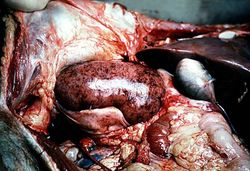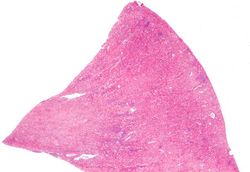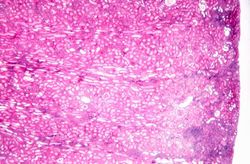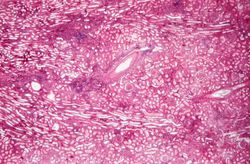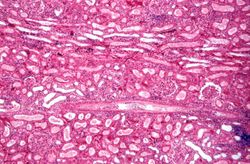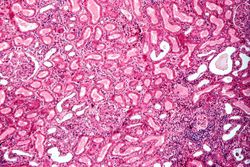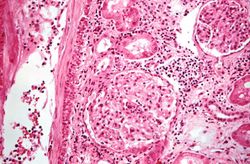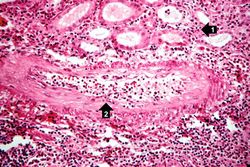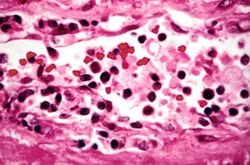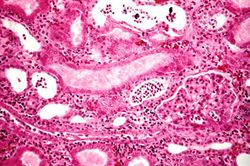Difference between revisions of "IPLab:Lab 6:Acute Rejection"
Seung Park (talk | contribs) |
|||
| Line 18: | Line 18: | ||
File:IPLab6AcuteRejection10.jpg|This high-power photomicrograph demonstrates the cellular infiltrate within the interstitium and cells within the renal tubules. | File:IPLab6AcuteRejection10.jpg|This high-power photomicrograph demonstrates the cellular infiltrate within the interstitium and cells within the renal tubules. | ||
</gallery> | </gallery> | ||
| + | |||
| + | == Study Questions == | ||
| + | * <spoiler text="What cells make up the interstitial infiltrate seen in this case of acute transplant rejection?">Mononuclear cells - primarily CD4+ and CD8+ lymphocytes.</spoiler> | ||
| + | * <spoiler text="What is the cellular response seen in the acute rejection vasculitis in this case of acute transplant rejection?">Neutrophils are recruited to the lesions due to immunoglobulin deposition and complement fixation. There is also deposition of fibrin and thrombosis.</spoiler> | ||
{{IPLab 6}} | {{IPLab 6}} | ||
[[Category: IPLab:Lab 6]] | [[Category: IPLab:Lab 6]] | ||
Revision as of 15:38, 21 August 2013
Clinical Summary[edit]
This 34-year-old white male with end-stage chronic glomerulonephritis had been receiving hemodialysis three times per week for 4 months when he was admitted to the hospital for a living related-donor transplantation from his mother. Other than the kidney disease, the patient was in good health. The transplant was performed successfully with no complications. However, eight days later, transplant rejection necessitated returning the patient to the operating room for a nephrectomy of the transplanted kidney. After the nephrectomy, the patient did quite well, was returned to hemodialysis, and was discharged home in good condition.
Autopsy Findings[edit]
The kidney weighed 240 grams and was edematous. The capsule stripped with ease to reveal a pale tan-brown cortex which was irregularly red-mottled. Upon sectioning, the cortical band was ill-defined, and the corticomedullary junction was not well-demarcated. The renal papillae were edematous and the renal pelvis displayed generalized petechial hemorrhages which extended through the 7-cm segment of ureter to a diffusely hemorrhagic terminal portion.
Images[edit]
Study Questions[edit]
A normal kidney weighs 157 grams (range: 115 to 220 grams).
An infiltrate is an accumulation of cells in the lung parenchyma--this is a sign of pneumonia.
An infiltrate is an accumulation of cells in the lung parenchyma--this is a sign of pneumonia.
